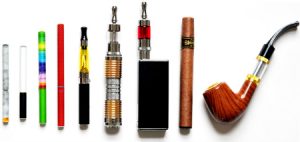Growing Health Concern for Our Youth Electronic Nicotine Delivery Systems (ENDS)

- how e-cigarettes work,
- what these devices look like,
- the prevalence of e-cigarettes among youth,
- the associated health risks,
- JCSD policies on e-cigarettes, and
- requesting your help in discussing these harmful products with your children.
Please review the following information shared by the FDA and Surgeon General. In addition, we encourage you to watch this nine minute informative PBS segment regarding vaping and health risks. VIDEO: Educators Worry Students Don’t Know Vaping Health Risks
Thank you for taking time to review this information. Please reach out to your school’s nurse if you have any questions or concerns.
How do e-cigarettes work?
- E-cigarettes heat a liquid (that may contain nicotine, as well as varying compositions of flavorings, propylene glycol, vegetable glycerin, and other ingredients) into an aerosol that the user inhales; this process is referred to as vaping.
- Users report feeling a nicotine high; second-hand smoke/vapor is also harmful to individuals standing near a user.
- “JUUL” is one of the most popular brands for vaping products.
- The liquid comes in over 7,000 flavors such as mango, chocolate, mint, and gummy bear, making it even more enticing for youth.
What do e-cigarettes look like?
- Manufacturers can develop e-cigarettes to look like a cigarette, pipe, or a cigar which are easier to recognize.
- However, e-cigarettes can also be developed to resemble a pen, USB stick, or larger device known as a tank system, making it more difficult to distinguish a vape pen from a real pen or a vape-stick from a USB stick (see photo below from FDA.gov).
Are children using e-cigarettes?
- More than two million middle and high school students were current users of e-cigarettes in 2016.
- E-cigarette use rose from 1.5 percent to 16.0 percent among high school students and from 0.6 percent to 5.3 percent among middle school students from 2011 to 2015; thus, we’d anticipate the number of users has continually increased over the past three years.
- According to a 2013-14 survey shared by the FDA, 81 percent of current youth e-cigarette users cited the availability of appealing flavors as the primary reason for use.
How are e-cigarettes harmful to youth?
- As the device heats the liquid, individuals inhale the vapor (which may include nicotine and other harmful products) that lead to changes in the adolescent brain.
- The brain is the last organ in the human body to develop fully. Brain development continues until the early to mid-20s. Nicotine exposure during periods of significant brain development, such as adolescence, can disrupt the growth of brain circuits that control attention, learning, and susceptibility to addiction.
- The effects of nicotine exposure during youth and young adulthood can be long-lasting and can include lower impulse control and mood disorders.
- The nicotine in e-cigarettes and other tobacco products is highly addictive and can prime young brains for addiction to other drugs, such as cocaine and methamphetamine.
E-cigarettes Are Prohibited In Our Schools
We’d like to make sure students are aware that the possession or use (including sale or distribution) of tobacco or a look-alike substances (vape pen, e-cigarettes, etc.) by students is prohibited. Tobacco products in the possession of students will be confiscated with associated disciplinary actions. Tobacco, in all of its forms, is prohibited on school grounds. Please see our Student/Parent Handbooks for more information. These policies are meant to ensure that all students have an opportunity to learn in a healthy educational environment.
New research continues to emerge on e-cigarettes and their harmful effects on the health and well-being of youth, we will continue to keep our students, staff, and families informed.
A special thank you to our friends at Urbandale Community Schools for putting this information together and allowing us to share it with Johnston Community School District families.